The Museum Collections
Introduction
I. History and Art Collection
1. Icons of the 14th 19th centuries
icons of the 14th 17th century
2. Jewelry art of the 14th 20th century
jewelry art of the 14th 17th century
jewelry art of the 18th 19th century
the european silver 14th - 19th centuries
3. Small-size sculptures (works of metal, wood, bone)
XI the beginning of the XX century
Small-size sculptures 11th 17th century
Small-size sculptures 18th early 20th century
enamel of Troitza masters 15-8th early 20th century
5.Embroidery, lace, textiles of the 14th - early 20th century
icon and ornamental embroidery
gold and silver lace
6.Painting of the 18th 21st centuries
painting of the 18th 19th centuris
painting of the 20th 21st centuris
II.Manuscripts and old printed books of the 14th 17th century
IV.Lithography of the 18th 19th century
V.Numismatics
VI.Medals of the 18th - early 20th century
VIII.Archeology collection
IX. Russian folk and applied and decorative art of the 17th 21st c.
1. Artistic wood
folk carved and painted wood
wooden toys
house carving of Sergiev Posad
Khokhloma and Gorodets painting
2. Artistic textiles
embroidery and weaving
printed textiles and lace
Russian shawls
folk costumes
folk garments
printed cotton kerchiefs
|
Folk carved and painted wood 18th-19th centuries (P.4) |
|
Each subject in a country economy was decorated by a traditional list.
These elements constituted a drawing, always done in black, the inside of which was coloured with red lead. A very simple design of slightly slanting black and reddish-brown stripes ran along the top and bottom of the bin. The outside of the bin was covered with oil, which, when it dried, gave the painted design a warm golden tone. The warm red that dominates the painting blends well with the white background. The genre scenes are very skilfully incorporated in the foliate patterns and do not disturb their colour rhythm in the least. They were meant to convey wishes for prosperity and happiness.
|
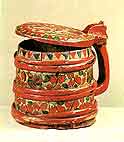
Wooden tankard. 19th century. Archangel Region |
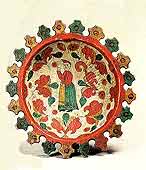
Plate. 19th century. Archangel Region |
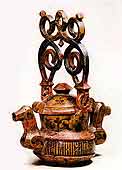
A wash-hand jug. 19th century. Archangel Region |
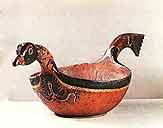
Carved and painted bowl. 18th century. Archangel Region |
|
|
Traditional medium-size vessels for beer or kvass were most common. They were beautiful in shape and extremely convenient to use. In the Kostroma Region they were very deep. Convenient handles were important in this case. Much attention was paid to their shape and decoration. The sides of the famous bowls made in the Tver Region, were slightly flattened beneath the two massive handles shaped to fit the hollow between the thumb and the index finger. It was undoubtedly easy and pleasant to handle a bowl so conveniently shaped.
The beer or mead was measured out of large bowls using wooden ladles of different shapes. In the Vologda Region they had a rounded, extremely plastic shape, the bowl merging into the magnificently carved handle in an extremely smooth and graceful way. In the Volga Area the bottom of the ladle was flat and the handle was almost perpendicular to the bowl. Ladles of all kinds invariably had a little delicately carved hook at the end of the handle by which they could be hung on the edge of a large bowl or a tub. . The giant bowl from the Zagorsk Museum collection can hold about 32 pints of liquid. The loop-shaped handle was evidently used to pull or turn the bowl on the table rather than to lift it.
The bowl was once brightly painted with cinnabar and decorated with a gilded inscription stating that it was given by Mikhail Maslov from the village of Minino in the Cheboksary District as dowry to his daughter Anna. Such a beautiful bowl was a fitting decoration on a festive table and the pride of its hospitable owners. Meant by the peasant artist to gladden the eye and the hearts of people, the bowl with its serene, austere beauty of shape and ornament never fails to please visitors to the Museum.
|
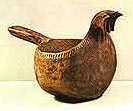
"Groom" beer bowl. Beginning of the 19th century. Tver Region |
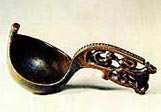
Bowl-ladle. 18th century. Vologda Region |
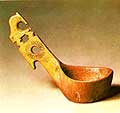
Ladle-scoop. First half of the 19th century. Volga Region |
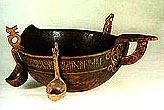
Festive bowl. 18th century. Volga Region |
|
The people longed beauty, and so the Russian peasant was surrounded with beautiful things from birth till old age. The cradle for the first-born was artistically decorated with a painted or carved Ornament. The first toy horse for the boy and the doll for the little girl were carved with skill and ingenuity. Many household objects made of the simplest and cheapest materials were adorned with beautiful painting or virtuoso carving. The people thought very highly of them since they brought joy and beauty into their lives. They will long continue to admire this beauty and draw inspiration from the inexhaustible source of folk art.
|
|
|


